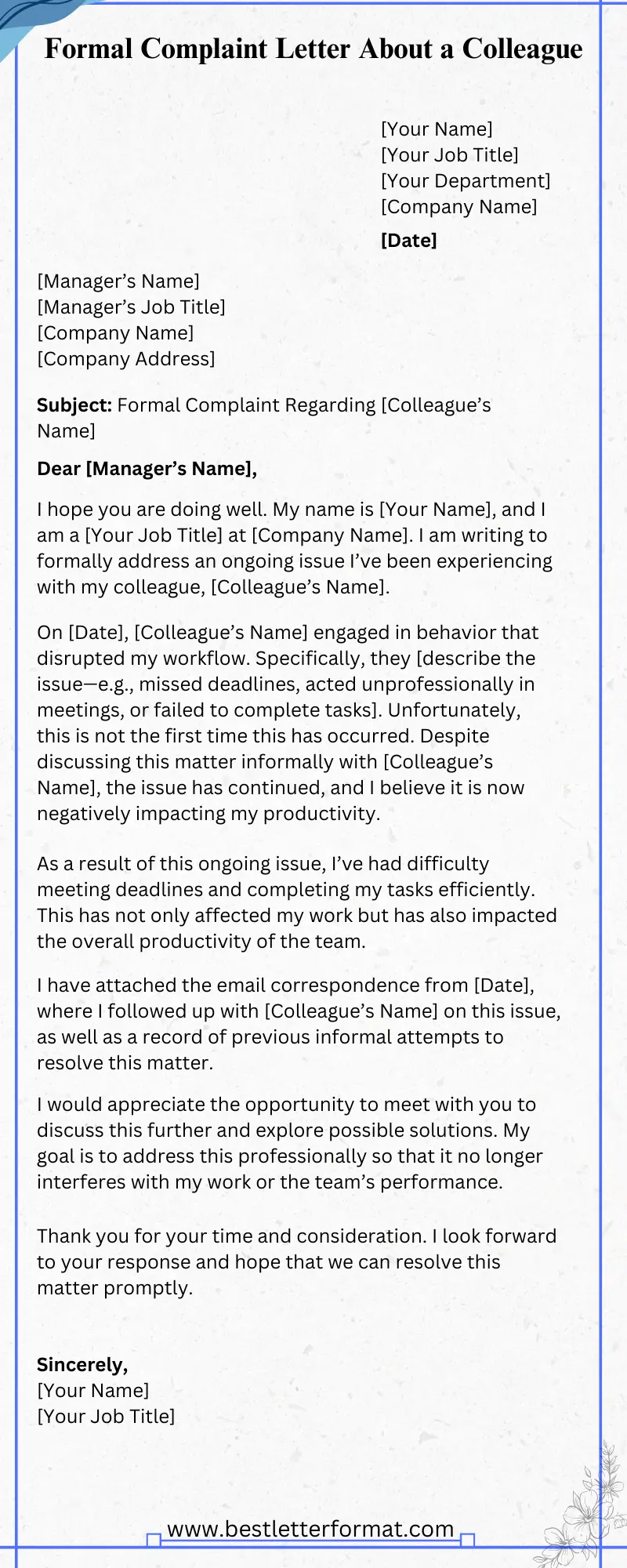How to Write a Formal Complaint Letter About a Colleague: A Step-by-Step Guide
Published: 3 Feb 2025
Hey, we’ve all been there. You’re sitting at your desk, staring at your screen, and suddenly BOOM your colleague does something that totally throws you off. Maybe it’s something small, like ignoring your emails, or something big, like making your workday harder than it needs to be. No matter what the situation is, you’re left thinking, “Do I really have to deal with this? Should I write a formal complaint letter?“

Writing a formal complaint letter might sound intimidating at first—like something you’d only do as a last resort. But here’s the truth: addressing the issue head-on in a calm, professional way can actually help improve things at work. And when you’re dealing with a colleague who’s affecting your productivity, your peace of mind, or the entire team, it’s something you don’t want to ignore.
In this guide, I’ll walk you through exactly how to write a complaint letter that’s respectful, effective, and—let’s face it—something you can actually feel good about sending. Let’s turn that frustration into a professional step forward and get this sorted the right way. Ready? Let’s dive in!
1. When Should You Write a Formal Complaint Letter About a Colleague?
Alright, before we dive into writing the letter, let’s take a quick moment to think about when you might actually need to write one. Sometimes, you might be thinking, “Is this situation serious enough to write a formal letter?”
Well, here are a few signs that it might be time to take that step:
- The issue is affecting your work: If your colleague’s behavior is starting to impact your productivity, deadlines, or overall job satisfaction, it’s definitely worth addressing.
- You’ve tried to handle it informally: Maybe you’ve already had a friendly chat with them or mentioned it casually, but nothing has changed. A formal letter helps to escalate things and makes it clear that it’s an important matter.
- It’s an ongoing problem: One-off incidents happen, but if this is a pattern, then it’s a bigger issue. A formal letter can help put things on record and set the stage for resolution.
- You need documentation: If the situation might require HR intervention later, having a formal record can be really helpful.
If any of these sound familiar, then it’s time to think about writing that letter. No stress—this is just about putting your thoughts together in a way that can help improve the situation. We’ve got this!
2. Step-by-Step Guide: Writing Your Formal Complaint Letter About a Colleague
Ready? Let’s go through each step to help you craft a well-written, professional complaint letter. And don’t worry, I’m going to keep things easy to follow!
1. Start with Your Contact Information (Top Left Corner)
First things first, at the top of your letter, you’ll want to include your own contact details. These are usually placed in the top left corner.
Example:
[Your Name]
[Your Job Title]
[Your Department]
[Company Name]
[Company Address]
[Email Address]
[Phone Number]
2. Date
Add the date you are writing the letter. This helps keep everything organized and adds a formal touch.
Example:
[Date] {DD, MM, YYYY}
3. Recipient’s Information (Below Your Details)
Next, you’ll need to add the recipient’s details—who you’re addressing this letter to. Typically, this is your direct manager or HR.
Example:
[Manager’s Name]
[Manager’s Job Title]
[Company Name]
[Company Address]
4. Subject Line (Optional but Helpful)
If you’re sending a letter, sometimes adding a subject line can make your purpose clear right from the start. You don’t always have to include one, but it helps.
Example:
Subject: Formal Complaint Regarding [Colleague’s Name]
5. Salutation/Greeting
Start your letter with a polite greeting. This sets the tone for the entire letter.
Examples:
- “Dear [Manager’s Name],”
- “To Whom It May Concern,” (If you don’t know who will be reading it)
6. Introduce Yourself & State the Purpose
This part should be short and clear. Tell them who you are, your job title, and the reason you’re writing this letter.
Example:
“My name is [Your Name], and I am a [Your Job Title] at [Company Name]. I am writing to formally bring to your attention an ongoing issue I’ve been experiencing with my colleague, [Colleague’s Name].”
7. Describe the Problem (Clearly and Factually)
This is where you lay it all out. You want to explain what happened in a clear, factual manner. Avoid emotions here—just the facts. Tell them exactly what the colleague did, when it happened, and why it’s an issue.
Example:
“On [Date], [Colleague’s Name] engaged in behavior that disrupted my workflow. Specifically, they [describe the issue—e.g., missed deadlines, failed to complete tasks, or were disrespectful in meetings]. This has happened multiple times, despite attempts to address it informally.”
8. Explain the Impact on Your Work
Now, explain how this behavior has impacted your ability to do your job. This is important because it shows that the issue is affecting your productivity or the work environment.
Example:
“As a result of this ongoing issue, I have had difficulty meeting deadlines and completing tasks on time. This has not only affected my own productivity but has also disrupted the team’s overall efficiency.”
9. Provide Evidence (If Any)
If you have any proof (emails, records of conversations, etc.), now is the time to mention it. This adds weight to your complaint and shows that you’re serious about addressing the issue.
Example:
“I have attached email correspondence from [Date] where I attempted to follow up on the issue. Additionally, I’ve included a record of my previous informal attempts to resolve this matter with [Colleague’s Name].”
10. Suggest a Resolution or Outcome
You’re not just raising the issue—you’re offering a way forward. What do you want to happen next? Be clear about what you’re hoping to achieve with this letter.
Example:
“I would appreciate the opportunity to meet with you to discuss this further and explore possible solutions. I believe a formal discussion can help resolve this issue and improve the working environment for everyone.”
11. Conclusion and Gratitude
Finish the letter by thanking the reader for their time and expressing your hope for a resolution. Keep the tone respectful and professional.
Example:
“Thank you for taking the time to read and consider my concerns. I am confident that we can resolve this matter swiftly, and I look forward to your response.”
12. Sign Off
Lastly, wrap it up with a professional closing. This adds the finishing touch to your letter.
Example:
“Sincerely,”
[Your Name]
[Your Job Title]
3. Complete Example of a Formal Complaint Letter About a Colleague
[Your Name]
[Your Job Title]
[Your Department]
[Company Name]
[Company Address]
[Email Address]
[Phone Number]
[Date]
[Manager’s Name]
[Manager’s Job Title]
[Company Name]
[Company Address]
Subject: Formal Complaint Regarding [Colleague’s Name]
Dear [Manager’s Name],
I hope you are doing well. My name is [Your Name], and I am a [Your Job Title] at [Company Name]. I am writing to formally address an ongoing issue I’ve been experiencing with my colleague, [Colleague’s Name].
On [Date], [Colleague’s Name] engaged in behavior that disrupted my workflow. Specifically, they [describe the issue—e.g., missed deadlines, acted unprofessionally in meetings, or failed to complete tasks]. Unfortunately, this is not the first time this has occurred. Despite discussing this matter informally with [Colleague’s Name], the issue has continued, and I believe it is now negatively impacting my productivity.
As a result of this ongoing issue, I’ve had difficulty meeting deadlines and completing my tasks efficiently. This has not only affected my work but has also impacted the overall productivity of the team.
I have attached the email correspondence from [Date], where I followed up with [Colleague’s Name] on this issue, as well as a record of previous informal attempts to resolve this matter.
I would appreciate the opportunity to meet with you to discuss this further and explore possible solutions. My goal is to address this professionally so that it no longer interferes with my work or the team’s performance.
Thank you for your time and consideration. I look forward to your response and hope that we can resolve this matter promptly.
Sincerely,
[Your Name]
[Your Job Title]

4. Different Types of Formal Complaint Letters About a Colleague
Now that we’ve covered the general structure for writing your complaint letter, you might be wondering, “Are all complaint letters the same?” Well, not really! There are a few different types of complaints you might need to address, depending on the situation. Here are common types of formal complaint letters about a colleague:
- Complaints About Unprofessional Behavior: When a colleague behaves rudely, disrespectfully, or disruptively in the workplace.
- Complaints About Poor Performance or Lack of Productivity: When a colleague fails to meet deadlines, complete tasks, or perform their duties properly, impacting your work.
- Complaints About Workplace Harassment: When a colleague engages in inappropriate behavior, whether it’s sexual, verbal, or emotional harassment.
- Complaints About Discrimination: When a colleague discriminates against others based on race, gender, age, disability, etc.
- Complaints About Verbal Abuse or Bullying: When a colleague repeatedly insults, intimidates, or bullies others in the workplace.
- Complaints About Failure to Collaborate or Teamwork: When a colleague refuses to participate in group activities, ignore team tasks, or creates friction in collaborative efforts.
- Complaints About Breaching Company Policies or Ethics: When a colleague violates workplace rules, such as ethical codes, confidentiality agreements, or health and safety protocols.
- Complaints About Excessive Absenteeism: When a colleague frequently takes unexcused leaves, showing disregard for the team’s schedule and workload.
- Complaints About Dishonesty or Lying: When a colleague provides false information or lies about their work, affecting project outcomes or team dynamics.
- Complaints About Misuse of Company Resources: When a colleague uses company resources (e.g., office supplies, computers, or funds) for personal purposes, violating company policies.
5. Tips for Writing an Effective Formal Complaint Letter About a Colleague
Before you hit send or hand in your letter, here are a few tips to keep in mind. These will help ensure your letter comes across professionally, and that you’re taken seriously:
- Be Clear and Concise: Avoid unnecessary details. Stick to the main facts. The goal is to get your point across quickly and professionally.
- Stay Professional: It’s tempting to vent your frustrations, but try to keep your emotions in check. A formal complaint is about resolving an issue, not airing grievances.
- Use Specific Examples: When describing the issue, provide clear examples of what happened. This helps the reader understand the situation better and gives weight to your complaint.
- Stick to the Facts: Avoid making assumptions or including hearsay. Focus on what you know for sure. It makes your letter stronger.
- Be Solution-Oriented: Rather than just complaining, offer a solution or suggest a way forward. This shows you’re willing to work on the issue constructively.
- Proofread: Before submitting, check for grammar and spelling errors. A letter with mistakes can make you seem unprofessional. A little proofreading goes a long way!
FAQs About Writing a Formal Complaint Letter to a Colleague
Writing a formal complaint letter can raise a lot of questions. Don’t worry, I’ve got you covered! Here are some frequently asked questions to guide you further:
A formal complaint letter should include a clear description of the issue, relevant dates and examples, how it affects your work, and a suggested resolution.
Keep your letter concise, ideally no longer than one page. Focus on the main points to keep it clear and professional.
While some workplaces may allow anonymous complaints, it’s generally better to include your name. It adds credibility and makes it easier to resolve the issue.
If your complaint involves harassment or discrimination, be sure to mention the specific behavior, any relevant witnesses, and how it impacted your work. This is a serious matter, and it should be addressed appropriately.
Start by clearly stating the issue. Begin with a professional tone and avoid emotional language. For example, “I am writing to address a concern regarding [issue].”
It’s always a good idea to first try to address the issue directly with your colleague, especially for minor concerns. If the problem persists, then a formal letter is your next step.
Yes! If you feel uncomfortable addressing the issue directly with your colleague or if the problem is severe, you can send the letter to HR instead.
Your tone should be professional, respectful, and neutral. Avoid sounding accusatory or emotional. Stick to the facts to maintain credibility.
Be specific and professional. Provide clear examples, stay solution-oriented, and follow the correct channels (HR or supervisor) for addressing the issue.
Yes, it’s good practice to suggest a resolution or next steps in your letter. This shows you’re focused on finding a positive outcome and resolving the situation constructively.
Conclusion
So guys, in this article, we’ve covered how to write a formal complaint letter about a colleague in detail. Writing a formal complaint might feel overwhelming at first, but it’s an important skill that can help you resolve conflicts in a professional and constructive way. Whether it’s an issue with productivity, behavior, or communication, addressing it formally can clear the air and create a more positive work environment.
Here’s a little advice to wrap things up:
- Stay calm and professional throughout the process.
- Focus on facts, not emotions.
- Keep your goal in mind—finding a resolution, not just complaining.
If you’re facing a challenging situation at work, remember that writing a formal complaint letter is a mature and professional step toward resolution. Don’t hesitate to take action—doing so can make a real difference in how things progress.
Before you go, I’d love for you to share this article with anyone who might need it. Sharing knowledge helps us all grow and build better workplaces. Also, if you found this article helpful, feel free to bookmark the site, so you can always come back when you need more tips. We’re here to help you with all your professional needs!

- Be Respectful
- Stay Relevant
- Stay Positive
- True Feedback
- Encourage Discussion
- Avoid Spamming
- No Fake News
- Don't Copy-Paste
- No Personal Attacks

- Be Respectful
- Stay Relevant
- Stay Positive
- True Feedback
- Encourage Discussion
- Avoid Spamming
- No Fake News
- Don't Copy-Paste
- No Personal Attacks








